OH! Before we get in to that, though, I wanted to remember to mention this: although MiB's sweaters may be written out for men or women, I encourage everyone to experiment! Sometimes the only difference between a men's sweater and a women's sweater is the presence of waist shaping and some simple proportion changes (like yoke depth, arm/body length). If you've fallen for a specific design but it's for the wrong gender, please feel free to use the pattern as a guide: take measurements off of a sweater you love (and whose fit you agree with) and go for it! And with that brief soap-box moment out of the way, I present the sweaters:
Meet Stilwell.
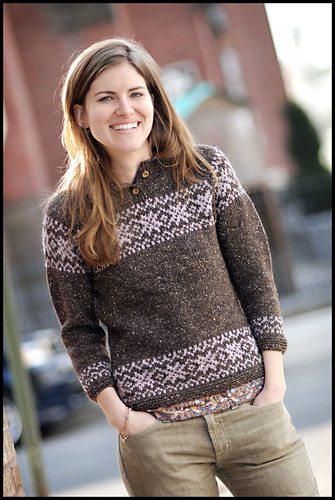
More colorwork. More tweed. When I first got the colorcard for Portland Tweed, I was playing with a lot of combos and this one kept coming back to me as something I'd like to knit with. A rich, chocolaty brown coupled with a very dusty, subtle, almost grey (my favorite adjectives for almost any color) shade of pink.
It's a good old fashioned seamless raglan ("If it ain't broke, don't fix it" comes to mind) with some colorwork detailing on the yokes and cuffs. I wanted to do a bit of mixing and matching of styles with traditional Norwegian star motifs and more contemporary elements like a fitted body, 3 quarter length sleeves and shaped collar.
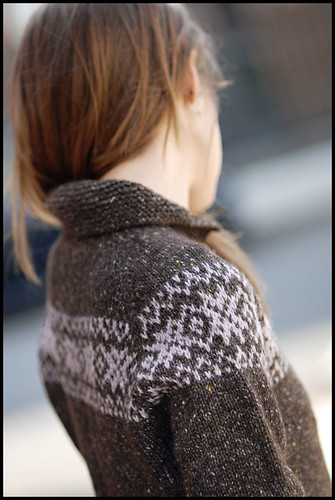
The piece is worked with a henley neck as well. For colorwork patterns, I instruct knitters to use one needle size for one-color stockinette portions, and a larger needle size (2 or 3 sizes up, whatever gets you correct gauge) for all colorwork portions. This is necessary to obtain the same stitch gauge between two different fabrics within one garment. Row gauge is significantly different in colorwork, but that's been accounted for in the design, so stitch gauge is the key - in this way the tension in the fabric is kept constant throughout.
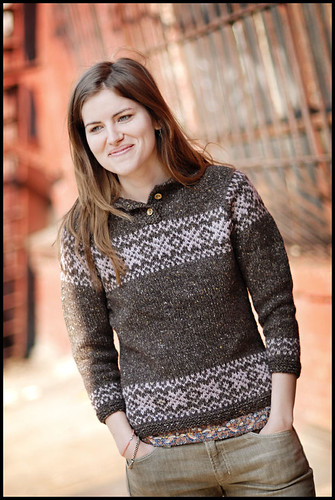
I remember knitting a colorwork yoke sweater from a pattern years ago, all with the same needle size, and how the tension change in the yoke drove me crazy. I've since been experimenting with ways of never making that happen again. This works for me! Anyway - I guess what I'm trying to say is, to save time and frustration when knitting projects with both one-color and two-color stockinette portions, find what gets you the same stitch gauge for each and use those two needle sizes for best results.
Tangents! Tangents! Ahem.
Meet Redhook.

One of the reasons I love Fall so much is the prevalence of layering. People are rocking the layered look everywhere you look and that makes for interesting and inspiring style, not to mention a good way to mix up a wardrobe that can start to feel reeeeaally boring after all those stifling summer months of wearing one thing at a time. Layering is all about contrast: long and short garments, fabric weights and warmths, and maybe most importantly, color! So with all of that in mind, Redhook was conceived as a fun monkey wrench to throw into your layering mix. Vests in general are great for this type of thing because they can be worn under outerwear with no bulk at the arms, and less overheating.
I wanted a garment that could be worn as a stand-alone, or layered easily, had a simple shape and a couple of nice details - like a luxurious collar! I can't get enough of those.

I also fell in love with this color. Moorland is a single-ply heathered yarn that comes in a wonderful group of earthtones (very, very hard to make color decisions on this one). The thing that really floored me about the yarn was the drape after washing - it got super silky and smooth, and very much took me by surprise after I picked it up off the blocking board (who am I kidding, the carpet of a guest room in Portland, Oregon). It was warm and light, and even more perfect for pairing with other clothes. Bonus points!
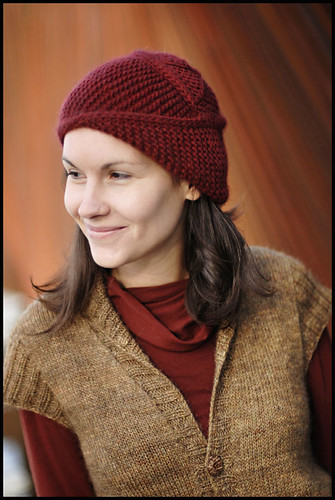
Redhook involves lots of fun with short-rows. Both sleeve caps and shawl collar/buttonband are all worked directly off of the body fabric from picked-up sts and shaped with short rows.
And finally, Seneca.
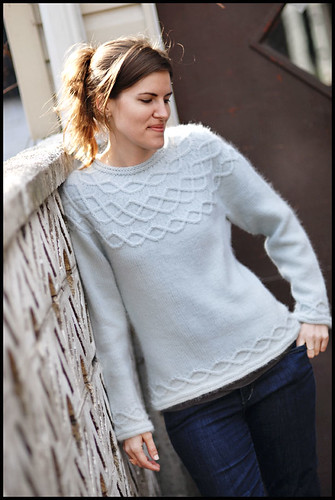
Sometimes, scratch that, most times, design ideas hit you at the oddest times. Like when you're sitting, twitching, in jury duty (which makes it even more unbearable, as you're already thinking about how much you'd rather be at home knitting). I had been wanting to knit a rounded yoke pullover with cables that weren't vertical, and desperately wanted to keep it all in one piece. I had been chewing on that idea until BAM! Jury duty brought me to sideways cables.

Sideways cables are interesting - if you've never worked them, here's how they roll: They seem as if to appear out of nowhere on a stockinette or reverse stockinette background. This occurs by a severe increase, usually 5 stitches into one and working the cable directly from that point. When the cable is done, you use a fancy 5-to-1 decrease and you're back to your stockinette fabric. They're like little intermissions from your mindless stockinette meditation.
AND - they perfectly suit round yoke sweaters, which are shaped with intermittent decrease rings throughout the yoke - in Seneca, they're stashed between cable motifs, so that the stitch counts are never interrupted when cabling, which is a major sigh of relief.

A note before I forget about this one: Because of the rather dramatic nature of the fabric manipulation - the severe increasing for the cables and severe decreasing for the round yoke - you'll definitely want to do an official blocking job (I really recommend full-immersion for this) to smooth all of that out after completion. Sweater fabric always looks better after this process, (always) but this sweater benefits from it especially.
Sidways cables are also thrown in on the cuffs for a little extra interest and weight there. Because the sweater is a worsted weight fabric, I generally advise about 3-5" of ease for a classic fit. My model was about 5-6" smaller than the garment and liked the cozy feeling of a little ease added in. I'm a big fan of a little room in my sweaters, especially in warmer fibers like angora.
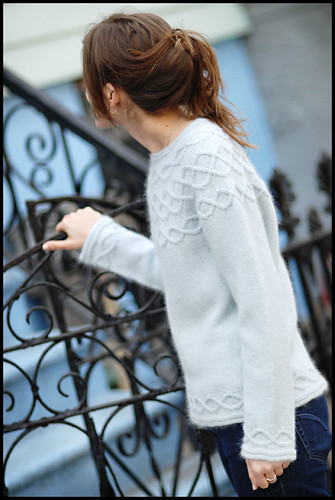
That rounds out the sweater portion of this tour. Stay tuned for the last two stragglers from the booklet in the next couple of days.
____________________________________________
RAVELRY Links
Stilwell on Ravelry
Redhook on Ravelry
Seneca on Ravelry (Also available as an individual PDF download)
0 comments:
Post a Comment